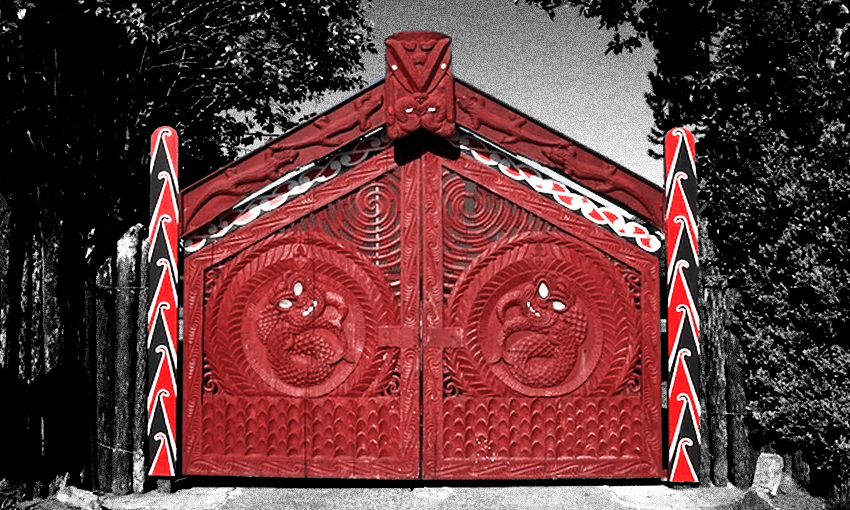It might look like he forgot a few pleasantries but Goff’s actions are simply the latest in a long history of ignoring Māori.
Ahead of King Charles’s coronation, a gathering of New Zealand attendees took place at the High Commission in London this morning. The event was hosted by High Commissioner Phil Goff and attended by Kiingi Tuheitia, along with dignitaries like Governor General Dame Cindy Kiro, Dame Rangimārie Naida Glavish and prime minister Chris Hipkins.
During the event, first in te reo Māori and then in English, Kiingitanga chief of staff archdeacon Ngira Simmonds addressed the room, to scold high commissioner Phil Goff for dismissing tikanga Māori and offending Kiingi Tuheitia over the course of the proceedings.
“I’ve actually just expressed significant disappointment at what has taken place here,” Simmonds said. “When that happens, the experience that we feel as Māori are pushed down in the life of our nation and Pākehā are lifted up.”
That disappointment revolved around Goff forgetting to perform a karakia to open the event, and then going on to say that no one in the room had experienced a coronation before. “I don’t think Māori can stay silent when we experience things like we did this afternoon,” Simmonds said.
Phil Goff later apologised for not following protocol.
Some have described the situation as a faux pas, others have described it as more than just a mere oversight – so why exactly was this all so bad?
- Firstly, opening with a karakia is really important in Aotearoa and it’s usually incorrect to skip that regardless of who is at an event
……but especially when a Māori monarch is there and it’s for such an occasion as weighty as this. While this event took place in the UK, and could easily be dismissed as simply a “when in Rome”-type situation, the New Zealand High Commision is still a representative of the New Zealand government and of our country overseas. “Our point of difference is our tikanaga from home that we take with us,” Rahui Papa, kaikoorero for Kiingi Tuheitia told RNZ.
- Kiingi Tuheitia is a king and, for all intents and purposes, a peer of King Charles
The lack of recognition of the significance of karakia to Māori and lack of acknowledgement was taken so poorly because of the status of Kiingi Tuheitia and of the history behind that position. The Kiingitanga or Māori King Movement emerged among a group of iwi in the central North Island as a mechanism to protect Māori land ownership and constitutional autonomy by establishing roles similar in status to those of the British who colonised Aotearoa. The movement was properly established in 1858, when the first Māori king Pōtatau Te Wherowhero was installed, and has seen six monarchs since. While the Kiingitanga might be seen as a challenge to the British, it was for the most part born out of a sense of respect for the mana of the British monarchy of that time – the close relationship between the two royal families endures today.
Unlike the British monarchs, the kings and queens of the Kiingitanga technically operate in a non-constitutional capacity and without legal or judicial power within the New Zealand government. However, they play a crucial role politically and culturally by bringing together otherwise independent iwi to safeguard whenua and taonga, they also wield significant lobbying power and mana.
Speaking to Morning Report, Chris Hipkins acknowledged that the lack of recognition for Kiingi Tuheitia was flawed. “It was a mistake. I think it is important, you know, in these sorts of events that we do acknowledge the Crown-Māori relationship, and Kiingi Tuheitia clearly has a relationship with the Crown over here – we should acknowledge that.
“The fact that he’s here, I think, is a recognition of that, you know – here as part of the New Zealand delegation. I think it’s important that we acknowledge and celebrate that.”
Rāwiri Waititi of Te Pāti Māori told RNZ that Goff’s comments reflected that Aotearoa had “a long way to go” to properly recognise tangata whenua.
- Kings and queens of the Kiingitanga movement also have coronations
Despite Phil Goff remarking that no one in the room had been to a coronation before, Kiingitanga chief of staff archdeacon Ngira Simmonds noted in his criticism that after King Charles’s coronation on Saturday, many people in the room will have actually been to three coronations.
“The complete disregard of the…coronation of Kiingi Tuheitia Potatau Te Wherewhero VII and of course his mother, the late Māori Queen. This will be Kiingi Tuheitia’s third coronation,” he said.
In 2006, Kiingi Tuheitia was crowned and in 1966, his mother and predecessor, Te Arikinui Dame Te Atairangikaahu was crowned. Koroneihana, a celebration of Kiingi Tuheitia’s coronation, is held annually at Tuurangawaewae marae in Ngāruawāhia.
This oversight by Goff has been taken as a dismissal of the Kiingitanga. As a fun thought experiment, imagine if the roles were reversed and King Charles arrived at the British High Commission in Wellington next week where someone made a sincere comment that this was everyone’s first coronation. It probably wouldn’t go down too well.
- Snubs from the government aren’t a new thing for the Kiingitanga
This isn’t the first time the government has overlooked the Kiingitanga in situations tied to British monarchy. When Queen Elizabeth visited New Zealand in 1953, Tuurangawaewae, the marae of the Kiingitanga, was not included in the itinerary. Instead, the queen and duke were scheduled to drive past the marae gates. The National government at the time ignored booming appeals for a change of schedule to include a visit to meet Te Arikinui Dame Te Atairangikaahu. Despite the ongoing brush-off, the Kiingitanga printed programmes and waiata practices took place. At last minute, on the morning of, the itinerary was changed to include a (strict) three-minute visit to the marae. Queen Elizabeth, greeted by waiata and haka, entered Māhinārangi, the carved meeting house at the marae, and ended up staying for 17 minutes.





